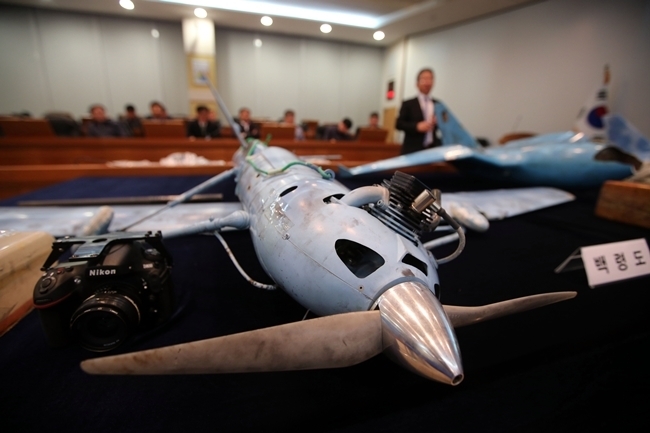Seoul finds ‘smoking gun’ proving N.K. sent drones
Seoul’s Defense Ministry said Thursday that its probe team had secured the “smoking gun” confirming that the three crashed drones, discovered in frontline areas in March and April, came from North Korea.
Announcing the result of its investigation, the investigation team, consisting of South Korean and U.S. experts, presented its analysis of photos and mission data from the drones’ cameras and memory chips, which revealed that they took off from the North and were programmed to return to the North.
“Analyzing the travel routes of the three drones, the investigation team secured definitive scientific evidence, or a ‘smoking gun,’ to prove that Pyongyang is responsible for sending the drones,” ministry spokesperson Kim Min-seok told reporters.
The military authorities discovered three drones, one in Paju close to the western Demilitarized Zone on March 24, one on the border island of Baengnyeongdo on March 31 and another in Samcheok, close to the eastern DMZ on April 6.
Based on its analysis, the ministry said that the drone found on Baengnyeongdo Island took off from 27 kilometers southeast of Haeju, Hwanghae Province. Its planned travel route, stored in the drone’s memory chip, matched the routes along which the drone took photos, officials explained.
|

|
|
A drone that came from North Korea (Yonhap)
|
The drone from Paju took off from 5 kilometers northwest of the North Korean border city of Gaeseong, while the drone from Samcheok originated from 17 kilometers east of Pyonggang in the North’s Gangwon Province.
Seoul officials suspect that the North produced the drones based on Chinese drones it imported via Hong Kong. Seoul has requested through a diplomatic channel that Beijing confirm if there was any connection between Chinese firms and Pyongyang authorities.
Seoul called the dispatch of the drones a clear military provocation and violation of the Armistice Agreement and a 1992 bilateral nonaggression pact. It said that it planned to ask the U.N. Command to send a warning to the North about the drone activities.
The drone case has triggered intense criticism of South Korea’s “porous air defense.”
The Japanese-made cameras of the drones turned out to have taken photos of major military installations on the frontline islands of Socheongdo and Daecheongdo, potential infiltration routes and even the presidential residence of Cheong Wa Dae.
Recognizing the drones as “real military threats,” Seoul has been pushing to reorganize its existing assets to better detect drone activities and purchase new military systems from overseas.
Seoul authorities are seeking to introduce 10 Israeli-made RPS-42 low-altitude radars, which will be posted to core state facilities including Cheong Wa Dae and western border areas. The authorities are also considering purchasing German-made laser-based weapons to shoot down hostile drones.
Pyongyang is expected to deny its responsibility for the drones having illegally entered South Korea’s airspace. On April 14, Pyongyang denounced Seoul for “fabricating” the drone case.
In the case of the sinking of the South Korean corvette Cheonan, the North also denied its responsibility although Seoul discovered the evidence to confirm that the ship was torpedoed by a midget North Korean submarine. The attack killed 46 South Korean sailors.
By Song Sang-ho (sshluck@heraldcorp.com)